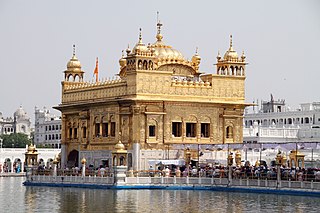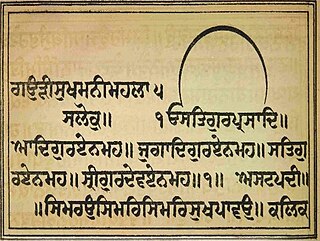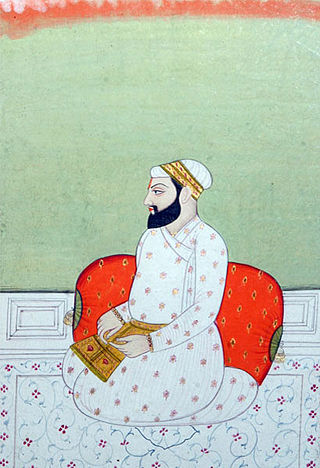Related Research Articles

Sikhism, also known as Sikhi, is an Indian religion and philosophy in particular for the Sikh ethnoreligious group that originated in the Punjab region of India around the end of the 15th century CE. The Sikh scriptures are written in the Gurumukhi script particular to Sikhs. It is one of the most recently founded major religious groups and among the largest in the world, with about 25–30 million adherents.

The Guru Granth Sahib is the central holy religious scripture of Sikhism, regarded by Sikhs as the final, sovereign and eternal Guru following the lineage of the ten human gurus of the religion. The Adi Granth, its first rendition, was compiled by the fifth guru, Guru Arjan (1564–1606). Its compilation was completed on 29 August 1604 and first installed inside the Golden Temple in Amritsar on 1 September 1604. Baba Buddha was appointed the first Granthi of the Golden Temple. Shortly afterwards Guru Hargobind added Ramkali Ki Vaar. Later, Guru Gobind Singh, the tenth Sikh guru, added hymns of Guru Tegh Bahadur to the Adi Granth and affirmed the text as his successor. This second rendition became known as the Guru Granth Sahib and is also sometimes referred to as the Adi Granth.
Waheguru is a term used in Sikhism to refer to God as described in Guru Granth Sahib. It is the most common term to refer to God in modern Sikhism.
The following outline is provides an overview of Sikhism, or Sikhi.

Sukhmani Sahib, known under the title of Gauri Sukhmani in the scripture, is usually translated to mean Prayer of Peace is a set of 192 padas present in the holy Guru Granth Sahib, the main scripture and living Guru of Sikhism from Ang 262 to Ang 296. This Gurbani text was written by the 5th Guru, Guru Arjan (1563–1606) at Amritsar in around 1602. Guru Arjan first recited the bani at Gurdwara Barth Sahib in the Gurdaspur district of Punjab, India.

Ik Onkar, also spelled Ek Onkar or Ik Oankaar ; literally, "one Om", hence interpreted as "There is only one God or one Creator") is a phrase in Sikhism that denotes the one supreme reality. It is a central tenet of Sikh religious philosophy.

The Sarbloh Granth or Sarabloh Granth, also called Manglacharan Puran or Sri Manglacharan Ji, is a voluminous scripture, composed of more than 6,500 poetic stanzas. It is traditionally attributed as being the work of Guru Gobind Singh, the tenth Sikh guru. Scholars, on the other hand, attribute the work to after the Guru's death, being authored by an unknown poet. The work is mostly revered by the Nihang sect.

The principal Sikh scripture is the Adi Granth, more commonly called the Guru Granth Sahib. The second most important scripture of the Sikhs is the Dasam Granth. Both of these consist of text which was written or authorised by the Sikh Gurus.

Guru Maneyo Granth refers to the historic statement of the 10th Sikh Guru, Guru Gobind Singh (1666–1708) shortly before his demise on affirming the sacred scripture Adi Granth as his successor, thereby terminating the line of human Gurus. Installed as the Guru Granth Sahib, it is now the central holy scripture of Sikhism, and the eternal living Guru of all Sikhs. It is central to Sikh worship as it is said to imbibe the one light of the creator manifested in the Ten Sikh Gurus‐one spirit in ten forms.

Guru Arjan was the fifth of the ten total Sikh Gurus. He compiled the first official edition of the Sikh scripture called the Adi Granth, which later expanded into the Guru Granth Sahib. He is regarded as the first of the two Gurus martyred in the Sikh faith.
Bhatt Kal Sahar was a Brahmin bard in the court of Guru Arjan, whose 54 hymns are incorporated in Adi Granth. The title Bhatt is given to learned Brahmins. Traditionally, Kal Sahar is believed to a collector of hymns of other Bhatts which were later incorporated into Guru Granth Sahib by Guru Arjan.

The Guru Granth Sahib, is the central religious text of Sikhism, considered by Sikhs to be the final sovereign Guru of the religion. It contains 1430 Angs, containing 5,894 hymns of 36 saint mystics which includes Sikh gurus, Bhagats, Bhatts and Gursikhs. It is notable among foundational religious scriptures for including hymns from writers of other religions, namely Hindus and Muslims. It also contains teachings of the Sikh gurus themselves.
Bhatt Balh was Brahmin bard in the court of Guru Arjan, whose five hymns are present in Guru Granth Sahib, the holy book of Sikhs.
Bhatt Bhalh was a Brahmin bard in the court of Guru Arjan, whose one hymn is present in Guru Granth Sahib, the holy book of Sikhs.
Bhatt Bhika was a Brahmin bard in the court of Guru Arjan, whose two hymns are present in Guru Granth Sahib, the holy book of Sikhs.
Bhatt Harbans was a Brahmin bard in the court of Guru Arjan, whose two hymns are present in Guru Granth Sahib, the holy book of Sikhs.
Bhatt Jalap was a Brahmin bard in the court of Guru Arjan, whose five hymns are present in Guru Granth Sahib, the holy book of Sikhs. Jalap
Bhatt Kirat was a Brahmin bard in the court of Guru Arjan, whose eight hymns are present in Guru Granth Sahib, the holy book of Sikhs. The title Bhatt is given to learned Brahmins.
Bhatt Mathura was a Brahmin bard in the court of Guru Arjan, whose 14 hymns are present in Guru Granth Sahib, the holy book of Sikhs. The title Bhatt is given to learned Brahmins and he is Bhatt Kirat’s brother.
Bhatt Nalh was a Brahmin bard in the court of Guru Arjan, whose 16 hymns are present in Guru Granth Sahib, the holy book of Sikhs.
References
- ↑ Page cxx, The Ādi-Granth, Or: The Holy Scriptures of the Sikhs, Ernst Trumpp, W.H. Allen, 1877
- ↑ Page 36, The Encyclopedia of Sikhism (over 1000 Entries), H. S. Singha, Hemkunt Press, 2000
- ↑ Page 8, The Sikh Review, Volume 55, Issues 1-6, Sikh Cultural Centre, 2007
- ↑ thesikhencyclopedia.com Archived 23 December 2015 at the Wayback Machine : BHATT BANI
- ↑ Grewal, Dalvinder Singh (2011). "Chanting 'Waheguru' is Pure Bliss!". The Sikh Review. 59 (691–696). Calcutta, India: Sikh Cultural Centre: 9.
- ↑ Singh, Pashaura; Fenech, Louis E., eds. (2014). "The Khalsa: Foundational Myth of the Sikh 'Nation'". The Oxford Handbook of Sikh Studies. Oxford Handbooks in Religion and Theology. Oxford: Oxford University Press. p. 272. ISBN 978-0-19-969930-8. OCLC 874522334.
Nanak conceived of God as the one and the only 'true sovereign' (Sacha Patishah) of the world; although the term Vahiguru first found in the hymns of Bhatt Gayand, the bard contemporary of Guru Arjan (the fifth Guru), is now more commonplace and used in the Sikh salutation (Vahiguru ji ka Khalsa Vahiguru ji ki Fateh).
- ↑ "Journal of Religious Studies". Journal of Religious Studies. 36. Punjabi University. Department of Religious Studies: 46.
Gayand composed 13 swayyas in praise of the fourth Guru whom he believes to be incarnate of the Divine. His 'Wah - Wah' phrase is popularly recited by the Sikhs